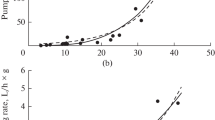Abstract
A survey of literature and of new information from the author's laboratory is presented concerning the comparative pressure physiology of marine invertebrates and fishes. Short term experiments on littoral marine animals have revealed that the taxonomic groups exhibiting the greatest resistance to high pressures are those with the greatest vertical distributions in the deep sea, namely, echinoderms, molluscs, amphipods, isopods and polychaetes. Shallow water species which possess high thermal and osmotic resistance also show an exceptionally high degree of pressure resistance. The relative differences in genetic pressure resistance of lower marine invertebrates are the same in whole, intact animals and in isolated, surviving tissue pieces. Adaptation of nonregulating euryoecous invertebrates to higher temperatures, higher osmotic concentrations and higher calcium contents of the tissues results in increased pressure resistance. Under pressure, the optimum cellular pH shifts downward to a lower pH range.
Similar content being viewed by others
Literature cited
Beebe, W.: 923 m unter dem Meeresspiegel, 255 pp. Leipzig: Brockhaus 1935.
Brown, D. E. S.: The effect of rapid changes in hydrostatic pressure upon the contraction of skeletal muscle. J. cell. comp. Physiol. 4, 257–266 (1934a).
—: The pressure coefficient of viscosity in the eggs of Arbacia punctulata. Physiol. 5, 335–346 (1934b).
—, F. D. Guthe, H. C. Lawler and M. P. Carpenter: The pressure temperature and ion relations of Myosin ATP-ase. J. cell. comp. Physiol. 52, 59–77 (1958).
Bruun, A. F.: Deep sea and abyssal depths. In: Treatise on Marine Ecology and Paleoecology. Mem. geol. Soc. Am. 67, 641–672 (1957).
Buch, K. und S. Gripenberg: Über den Einfluß des Wasserdruckes auf das pH und das Kohlensäuregleichgewicht in größeren Meerestiefen. J. Cons. perm. int. Explor. Mer 7, 233–245 (1932).
Ebbecke, U.: Über die Wirkung hoher Drucke auf marine Lebewesen. Pflügers Arch. ges. Physiol. 236, 648–657 (1935).
—: Lebensvorgänge unter der Einwirkung hoher Drucke. Ergebn. Physiol. 45, 34–183 (1944).
Ekman, S.: Zoogeography of the Sea, 417 pp. London: Sidgwick & Jackson 1953.
Fontaine, M.: Les fortes pressions et la consommation d'oxygène de quelques animaux marins. Influences de la taille de l'animal. C.r. Séane. Soc. Biol. (Paris) 99, 1789–1790 (1928).
Fontaine, M.: Recherches expérimentales sur les réactions des êtres vivants aux fortes pressions. Annls Inst. océanogr., Monaco 8, 97 pp. (1930).
Hardy, A. C.: The world of plankton. Pt. 1. The open sea: its natural history, 335 pp. London: Collins 1956.
Hill, E. P. and R. Y. Morita: Dehydrogenase activity under hydrostatic pressure by isolated mitochondria obtained from Allomyces macrogynus. Limnol. Oceanogr. 9, 243–248 (1964).
Johnson, F. H., H. Eyring and M. J. Polissar: The kinetic basis of molecular biology. Chapter 9: Hydrostatic pressure and molecular volume changes, 874 pp. New York: Wiley & Sons 1954.
Kitching, J. A. and D. C. Pease: The influence of hydrostatic pressure upon ciliary frequency. J. cell. comp. Physiol. 14, 135–142 (1939).
Knight-Jones, E. W. and E. Morgan: Responses of marine animals to changes in hydrostatic pressure. Oceanogr. Mar. Biol. Ann. Rev. 4, 267–299 (1966).
Marsland, D. A.: The effect of high hydrostatic pressure upon cell division in Arbacia eggs J. cell. comp. Physiol. 12, 57–70 (1938).
—: Mechanism of pigment displacement in unicellular chromatophores. Biol. Bull. mar. biol. Lab., Woods Hole 87, 252–261 (1944).
—: Temperature-pressure studies on the role of sol-gel reactions in cell division. In: The influence of temperature on biological systems, pp 111–126. Ed. by F. H. Johnson. Washington, D.C.: American Physiological Society 1957.
—: Cells at high pressure. Scient. Am. 199, 36–43 (1958).
— and D. E. S. Brown: Viscosity of Amoeba at high hydrostatic pressure. J. cell. comp. Physiol. 8, 159–165 (1936).
Menzies, R. J. and J. B. Wilson: Preliminary field experiments on the relative importance of pressure and temperature on the penetration of marine invertebrates into the deep sea. Oikos 12, 302–309 (1961).
Morita, R. Y.: Effects of hydrostatic pressure on marine microorganisms. Oceanogr. Mar. Biol. Rev. 5, 187–203 (1967a).
—: Effect of hydrostatic pressure on succinic, formic, and malic dehydrogenases in Escherichia coli. J. Bact. 74, 251–255 (1967b).
Naroska, V.: Vergleichende Untersuchungen über die Wirkung des hydrostatischen Druckes auf die Überlebensfähigkeit und die Stoffwechselintensität mariner Evertebraten und Teleostier. Nat. math. Diss. Kiel. Kieler Meeresforsch. 1968 (in press).
Ponat, A.: Untersuchungen zur zellulären Druckresistenz verschiedener Evertebraten der Nord- und Ostsee. Kieler Meeresforsch. 23, 21–47 (1967).
— und H. Theede: Die pH-Abhängigkeit der zellulären Druckresistenz bei Mytilus edulis. Helgoländer wiss. Meeresunters. 16, 231–237 (1967).
Regnard, P.: Recherches expérimentales sur les conditions physiques de la vie dans les eaux, 500 pp. Paris: Libraire de l'Academie de Medicine 1891.
Schlieper, C.: Blologische Wirkungen hoher Wasserdrucke. Experimentelle Tiefsee-Physiologie. Veröff. Inst. Meeresforsch. Bremerh. (Sonderbd.), 1, 31–48 (1963).
—: Genetic and nongenetic cellular resistance adaptation in marine invertebrates. Helgoländer wiss. Meeresunters. 14, 482–502 (1966).
—, H. Flügel and H. Theede: Experimental investigations of the cellular resistance ranges of marine temperate and tropical bivalves. Physiol. Zoöl. 40, 345–360 (1967).
Zenkevitch, L. A.: Erforschung der Tiefseefauna im nordwestlichen Teil des Stillen Ozeans. Publs. Un. int. Sci. biol. (Ser. B) 16, 72–85 (1954).
— and K. A. Birstein: Studies of the deep water fauna and related problems. Deep Sea Res. 4, 54–64 (1956).
Zobell, C. E.: The occurrence of bacteria in the deep sea and their significance for animal life. Publs. Un. int. Sci. biol. (Ser. B) 16, 20–26 (1954).
—: Thermal changes accompanying the compression of aqueous solutions to deep-sea conditions. Limnol. Oceanogr. 4, 463–471 (1959).
Author information
Authors and Affiliations
Additional information
Communicated by O. Kinne, Hamburg
Lecture presented on October 23, 1967 at Duke University, Marine Laboratory, Beaufort (USA); on November 6, 1967 at the Instituto di Biologia Marinha of the University of São Paulo (Brasil); and on November 8, 1967 at the Institute of Marine Science of the University of Miami (USA).
Rights and permissions
About this article
Cite this article
Schlieper, C. High pressure effects on marine invertebrates and fishes. Marine Biol. 2, 5–12 (1968). https://doi.org/10.1007/BF00351631
Accepted:
Issue Date:
DOI: https://doi.org/10.1007/BF00351631




